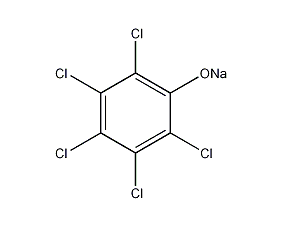Pentachlorophenol sodium salt


Structural formula
| Business number | 03MY |
|---|---|
| Molecular formula | C6Cl5ONa |
| Molecular weight | 288.32 |
| label |
Pentachlorophenol sodium salt, Sodium pentachlorophenol, Bactericidal algaecide |
Numbering system
CAS number:131-52-2
MDL number:MFCD00002163
EINECS number:205-025-2
RTECS number:SM6490000
BRN number:3639137
PubChem number:24886998
Physical property data
1. Appearance: white or light yellow needle crystal
2. Melting point (℃): 190
3. Solubility: easily soluble in water, ethanol, methanol, Acetone, slightly soluble in carbon tetrachloride and carbon disulfide.
Toxicological data
- Acute toxicity: Oral – rat LD50: 126 mg/kg; Oral – mouse LC50: 197 mg/kg.
- This product is irritating to the eyes and respiratory tract. Peripheral neuritis may occasionally occur in people with long-term exposure. It has an irritating effect on mucous membranes, and when the solution concentration exceeds 1%, it has an irritating effect on the skin.
Ecological data
It is a strong irritant, moderately toxic to humans and livestock, and highly toxic to fish. The lethal concentration for fish and shrimp isLC50 is 0.3-0.6mg/L.
Molecular structure data
None yet
Compute chemical data
1. Reference value for hydrophobic parameter calculation (XlogP):
2. Number of hydrogen bond donors: 0
3. Number of hydrogen bond acceptors: 1
4. Number of rotatable chemical bonds: 0
5. Number of tautomers:
6. Topological molecular polar surface area (TPSA): 23.1
7. Number of heavy atoms: 13
8. Surface charge: 0
9. Complexity: 155
10. Number of isotope atoms: 0
11. Determine the number of atomic stereocenters: 0
12. Uncertain number of atomic stereocenters: 0
13. Determine the number of chemical bond stereocenters : 0
14. Number of uncertain chemical bond stereocenters: 0
15. Number of covalent bond units: 2
Properties and stability
1. The aqueous solution is weakly alkaline, add acid to acidify itPH6.8-6.6all precipitates for pentachlorophenol. It is easy to decompose when exposed to sunlight, is stable when dry, and has a special smell.
2. When the concentration in the air exceeds the standard, a gas mask must be worn. Operators should wear�Acid-base work clothes, chemical-resistant gloves, and safety glasses if necessary. Minimize direct contact with this product as much as possible.
Storage method
Store in a ventilated, low-temperature, dry warehouse. Store separately from oxidants and food additives.
Synthesis method
1. Prepared by hydrolysis of hexachlorobenzene.
2.Pour chlorine gas into trichlorobenzene for chlorination to obtain hexachlorobenzene, and then heat it with a certain concentration of caustic soda solution to reach a certain temperature. Hydrolysis is carried out under certain temperature and pressure, and the reaction product can be cooled, crystallized, filtered and dried.
3.Using the invalid body of 666 as raw material, sodium pentachlorophenate is prepared through high-pressure hydrolysis. First prepare a sodium hydroxide solution with a concentration of 160g/L. The molar ratio of hexachlorobenzene to sodium hydroxide is 1: (2.5~2.6). Add hexachlorobenzene to the alkali solution, stir evenly and then send it to the hydrolysis kettle. Stir and heat up until the pressure reaches 2MPa, stop heating, and use the heat of reaction to increase the pressure to 2.55 MPa, the corresponding temperature is 230℃, keep it for nearly 20 minutes, and the hydrolysis will be completed. The product is obtained by releasing the pressure and discharging, cooling and crystallizing.
Purpose
1. This product is used as an antibacterial agent for plastics and rubber (natural latex). It has good sterilization and anti-mildew effects. It also has a certain effect on improving the mechanical stability and chemical stability of latex. It has a better effect when used together with ammonia. Usually its 20% aqueous solution is used, the general dosage is 0.3%, and the ammonia dosage is 0.1%. This product has low toxicity and can be used as an adhesive for food packaging materials. It is an effective antifungal agent. This product can also be used as a non-selective contact herbicide, mainly controlling weeds that propagate by seeds. This product is also used as a preservative for wood, starch, dextrin, casein, gelatin and other substances.
2.Fungicides. The usage concentration of sodium pentachlorophenate is generally 50mg/L. It is not suitable to be used with cationic agents (such as quaternary ammonium salts, etc.), but it is compatible with some anionic surfaces. The combined use of active agents can significantly reduce their dosage and improve the bactericidal effect.
3.Used as a preservative for water-based adhesives. Coating 0.8% to 1.0% solution of this product on wood can prevent wood mildew and decay. Treating textiles with 0.1% to 2.0% solution can meet antibacterial and mildew-proof requirements. It is also used as a preservative for leather, pulp, adhesives and coatings, etc. The dosage is generally 0.1% to 0.4%. It is also used as a contact herbicide for soil treatment and to eliminate molluscs such as snails and leeches. It has a killing effect on fungi and can prevent the growth of algae and slime mold. When used for sterilization and algae treatment of circulating cooling water, the concentration used is 100~500mg/L.
